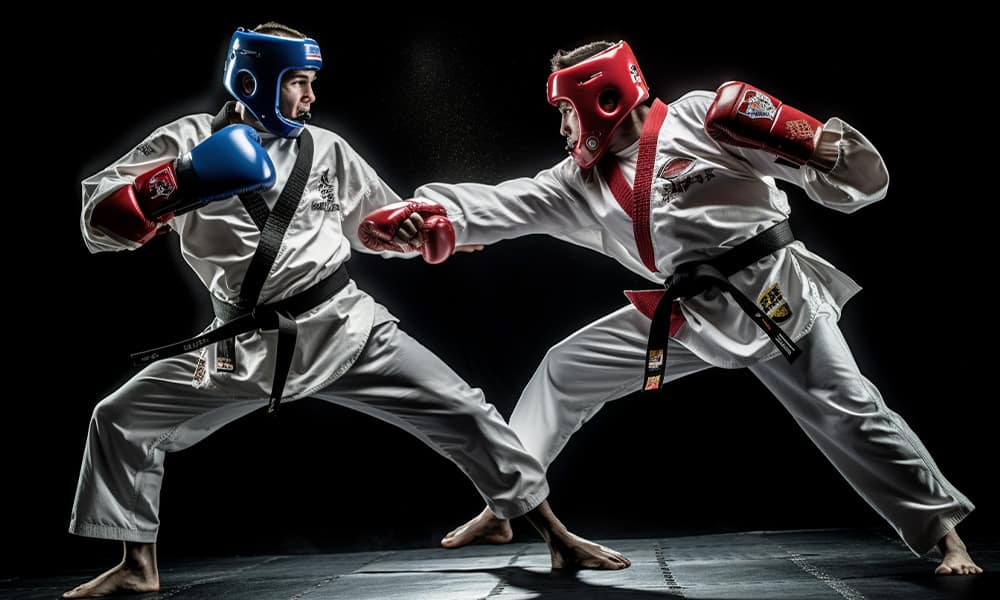
Martial arts like Taekwondo offer immense benefits – from fitness to self-defense to discipline. But many prospective students get deterred by the prospect of sparring. Is it possible to gain proficiency without it? In this blog post, we’ll explore whether you can truly learn martial arts without sparring.
First, we’ll look at the role of sparring and its benefits. Then we’ll examine alternative training methods like shadow boxing and drills. Finally, we’ll provide tips for getting the most out of your training if avoiding sparring. While sparring is undeniably useful, there are still ways to become skilled even if you opt out of physically fighting opponents.
The Role and Benefits of Sparring
Sparring involves free-form fighting practice with an opponent using martials arts techniques. It enables you to apply your skills under pressure and against resistance. Sparring hones timing, distancing, and control. It builds mental composure and emotional discipline. For schools focused on fighting applications, sparring is often essential for developing true combat capability.
Practicing against non-cooperative partners exposes weaknesses you wouldn’t see in choreographed drills. The intensity and adrenaline of sparring prepares you for the stress of real confrontations. Trading blows while mitigating damage also builds courage and confidence. Additionally, the competitive aspect motivates students to keep improving.
By experiencing techniques from opponents, you learn how to counteract and adapt strategies. Sparring builds reaction time, strategic thinking, and the ability to read body movements. The back-and-forth nature mimics actual combat, developing well-rounded fighting prowess. Many instructors believe sparring separates serious students with potential from casual participants looking for a hobby.
That said, while impactful for martial arts training, sparring has risks like injuries or developing aggressive tendencies. Students with anxieties or traumas related to combat may wish to avoid it. Next, let’s look at alternative training methods.
4 Alternatives to Live Sparring
While sparring has clear benefits, there are still ways to build significant skill without it:
1. Shadow Boxing
Shadow boxing involves imagined sparring against a phantom opponent. Though you don’t experience true impact or resistance, envisioning an adversary as you punch, kick, and maneuver improves form, timing, footwork, visualization, and flow between techniques. Practicing combos on bags or pads also helps ingrain movements.
2. Drills
Martial arts drills embed fighting reflexes by repeating specific techniques and scenarios. Options like bobbing and weaving through pads, knife defense drills, or grappling takedown drills imprint muscle memory and responses to common attacks. Doing drills at varying speeds or under time constraints boosts reaction skills.
3, Observation and Analysis
Studying footage of sparring or real fights allows you to integrate lessons on strategies, tells, weaknesses, distancing, and more without taking damage. Thoughtfully observing others trains your eye to pick up on subtle cues in an encounter.
4. Limited Sparring
If uncomfortable with unrestricted sparring, you can ease into controlled contact with protective gear. Going at reduced speeds, only using certain techniques, or stopping at lighter contact allows you to safely experience some live energy. You can also focus just on defense to get used to dealing with attacks without having to be offensive.
Making Progress Without Sparring
While lacking the intensity of unrestricted sparring, the above methods can still lead to significant growth. Consistent practice is key. Here are some tips to maximize your learning:
- Vary drills for diverse scenarios. Don’t get predictable.
- Practice with multiple partners having different styles and body types.
- Do drills at random intervals, not just preset patterns.
- Add obstacles like pads or balls to improve footwork and mobility.
- Occasionally do drills at full speed and power to increase realism.
- Get feedback from instructors to correct flaws you may not notice.
- Visualize sparring during solo practice. Stay mentally sharp.
- Watch matches to study strategy then replicate those situations through shadow boxing.
- Spar minimally (when comfortable) to test abilities against resistance.
Without open sparring, progress may be slower and you likely won’t reach the same pure fighting capabilities. But dedicating yourself to serious training through drills, observation, limited contact, and instruction can still make you highly competent. Result ultimately come down to effort.
Final Thoughts
Sparring develops martial arts skill in unique ways by pressure-testing abilities against non-compliant opponents. It hones timing, distancing, strategy, and mental toughness. But sparring isn’t absolutely necessary. Alternatives like drills, shadow boxing, observation, and limited contact can still foster substantial progress.
Without sparring, advancement takes greater discipline and analysis. But for students uncomfortable with combat, it’s possible to become proficient through mindful training. Consistency, effort, and diversity of methods are key.
Setbacks or slow progress don’t mean you can’t gain expertise. Stick with it and use all available methods to incrementally hone your skills over time.
